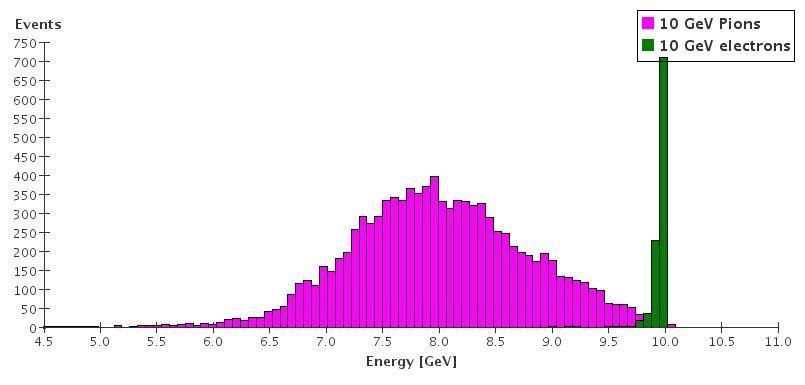Note: Work in Progress !!
Introduction
In this exercise we will use LCDD, an extension of the standard Geant4 GDML format, to describe a complete detector setup, including sensitive detectors and readout. Since we are using XML to configure Geant4 there is no need to write any C++ code. We can use a version of SLIC which has been pre-built with support for GDML included. In this example we will use a simple test beam like calorimeter consisting of lead glass blocks of 1 cubic cm. For each calorimeter cell we read out the Ionization loss as well as the energy deposited by cherenkov photons.
Principle of a dual read out calorimeter
For e+, e- and photons the total energy of the incoming particle is converted into detectable kinetic energy of electrons leading to excellent energy resolution for electrons/photons. Hadrons on the other hand break nuclei and liberate nucleons/nuclear fragments. Even if the kinetic energy of the resulting nucleons is measured, the significant fraction of energy is lost to overcome the binding energy. Fluctuations of the number of broken nuclei dominate fluctuations of the observed energy leading to a relatively poor energy resolution for hadrons. This is demonstrated in the figure below where the ionization loss of a 10 GeV Pion is compared with the ionization loss of a 10 GeV electron. In both cases we use a simple Iron block as an absorber that contains the entire shower.
Large number of broken nuclei:
- Large number of slow neutrons
- Small fraction of energy in a form of neutral pions.
Very few broken nuclei:
- Small number of slow neutrons
- Large fraction of energy in a form of neutral pions.
Eem/Etot ~ ECherenkov/Eionization
'EM' shower => Relativistic electrons => Lots of Cherenkov light
Hadronic shower => Most particles below the Cherenkov threshold
Use this fact to correct hadron response
Correlation between the total observed ionization energy and the electromagnetic component of the shower, as measured by the Cherenkov component. The calibration factor K is determined by the requirement that K×ECherenkov = Eionization for electrons.
